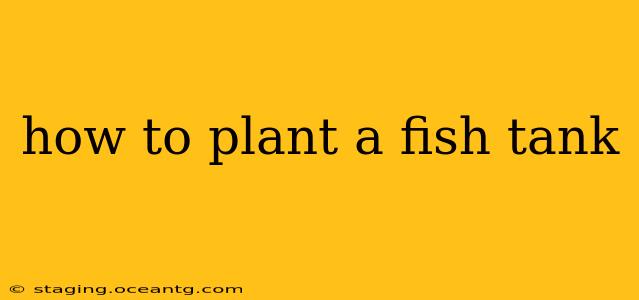Planting a fish tank, also known as aquascaping, transforms a simple glass box into a thriving underwater ecosystem. It's a rewarding hobby that enhances the beauty of your aquarium and provides a natural, enriching environment for your fish. This guide covers everything from choosing the right plants to maintaining their health, ensuring your fish tank becomes a stunning underwater paradise.
What are the Best Plants for Beginners?
Choosing the right plants is crucial for a successful planted tank. Beginners should opt for hardy, low-maintenance species that can tolerate a range of conditions. Some excellent choices include:
- Java Moss: Incredibly easy to care for, Java moss attaches to hardscape (rocks, driftwood) and requires minimal light.
- Anubias: Another low-light plant that thrives attached to hardscape, making it ideal for beginners.
- Water Sprite: A fast-growing, floating plant that helps absorb excess nutrients and provides shade.
- Hornwort: Another fast-growing, oxygenating plant that's incredibly easy to care for.
What Type of Substrate is Best for Planted Tanks?
The substrate is the foundation of your planted tank, providing essential nutrients for plant growth. Several options exist, each with its pros and cons:
- Gravel: A readily available and inexpensive option, but it offers limited nutrient retention.
- Sand: Provides a more natural look but also offers limited nutrient retention.
- Planted Tank Substrate (PTS): Specifically formulated to release nutrients gradually, supporting healthy plant growth. This is generally the best choice for beginners.
- Nutrient-rich Soil Cap: For experienced aquascapers, this provides the highest nutrient availability.
How Do I Plant Aquarium Plants?
Planting your aquarium plants correctly ensures their survival and growth. Here's a step-by-step guide:
- Prepare the substrate: Evenly distribute your chosen substrate in the tank, ensuring a consistent depth.
- Rinse plants: Gently rinse the plants to remove any debris or shipping material.
- Planting rooted plants: Make small holes in the substrate with your fingers and carefully plant the roots. Avoid burying the crown (the point where the stems and leaves emerge) too deeply.
- Attaching plants to hardscape: Secure plants like Anubias and Java moss to rocks or driftwood using fishing line or specialized plant glue.
- Floating plants: Simply gently place floating plants on the water's surface.
How Much Light Do Planted Tanks Need?
The lighting requirements vary depending on the plants you choose. Generally, a good rule of thumb is to provide at least 2-4 watts of lighting per gallon of water. Consider using a timer to maintain a consistent light cycle, typically 8-10 hours per day. High light conditions can lead to algae growth if not managed properly.
What Nutrients Do Aquarium Plants Need?
Aquarium plants need a variety of nutrients to thrive. These include:
- Macronutrients: Nitrogen (N), Phosphorus (P), and Potassium (K) are essential for overall plant growth.
- Micronutrients: Iron (Fe) and other trace elements are needed in smaller quantities but are crucial for healthy development. These are often included in liquid fertilizers.
How Often Should I Fertilize My Planted Tank?
The frequency of fertilization depends on the type of plants and the nutrient levels in your water. Start with a low dose and observe your plants' growth. If they show signs of deficiency (slow growth, yellowing leaves), increase the amount gradually. Over-fertilizing can lead to algae blooms.
How Can I Prevent Algae Growth in My Planted Tank?
Algae is a common problem in planted tanks. The best way to prevent it is to maintain a balanced ecosystem. This involves providing adequate lighting, proper fertilization, and regular water changes. Introducing algae-eating creatures such as snails or shrimp can also help.
What are the Benefits of a Planted Aquarium?
A planted aquarium offers many benefits beyond its aesthetic appeal:
- Improved water quality: Plants help absorb excess nutrients, reducing the risk of harmful algae blooms and ammonia spikes.
- Natural habitat for fish: Plants provide shelter, spawning grounds, and a more natural environment for your fish.
- Oxygen production: Plants produce oxygen, improving the water's oxygen levels.
- Stress reduction: The serene beauty of a planted tank can be relaxing and therapeutic for the owner.
By following these guidelines, you can create a beautiful and thriving planted aquarium that will bring years of enjoyment. Remember that patience and observation are key to success in aquascaping. With the right planning and care, your fish tank will become a captivating underwater world you'll be proud of.
